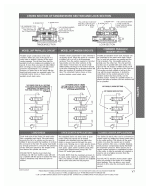</font><font color="blue" class="small">( All CUTS, SubCUTS and most utility tractors under 100 hp, regardless of color, use open center systems for their implement hydraulics. This means the pump is always pumping and the hydraulic fluid has to continuously flow from the pump thru the control valves and back to the reservior tank. Closed center systems are basically on-demand systems where the pump only pumps when a valve is actuated. These are used on some large ag tractors.
</font><font color="blueclass=small">( 4-way 3 position, 4-way 4 position, 3-way 3 position, work port blocked to tank in neutral, work port open to tank in neutral, open to tank in forth position or float, float, direct acting ball and spring relief,pilot acting relief and what ever else. )</font>
These terms refer to the types of spools that are available on most valves. For example, your loader valve has spools that are typically 3 position 4 way and one spool will have a float and the work ports (the lines to the cylinders) will be blocked from returning fluid back into the tank when the spool lever is in neutral.
The relief valve is what will open flow directly to the reservior tank outlet port if the pressure in the valve exceeds a certain limit. There are several different designs and configurations for relief valves.
If you go to the
Prince Hydraulics web site catalog section, you can find plenty of information on their various valves and configuration options, most of which will pertain to almost any valve.
)</font>
Very good description.
I would like to add, if it isn't obvious from Mad's post, that hydraulic valves are basically named after how many ports the have.
A "four way" valve, has 4 ports, a Presure port, a Tank port and two work ports, usually labled a and b.
A 4-way, three position means, the spool has three places it can be, in neutral, open center, p is connected to T, and if it is a "cylnder spool", ports a and b will be blocked. When the spool is shifted one way, P opens to port a, and port b is connected to tank.
In the other shifted position, P=>B, and A=> tank.
A float spool is a four position spool, with an open center small tractor, all ports are open to tank in float.
The situation is a little more complicated with what is typically called mobile circuitry, like on these tractors. There is actually a "parallel" passage which is a fifth land on the four way spool. The parallel passage allows oil to get to all the spools in the stack. When all the spools are in neutral, oil flows through the prallel passage to tank. When a spool gets shifted, the parallel passage is blocked, forcing the oil out the work port, rather than through the parallel passage to tank.
if a valve has "power beyond", the parallel passage is available to be connected to another downstream work function.
Hope this helps,
JT

